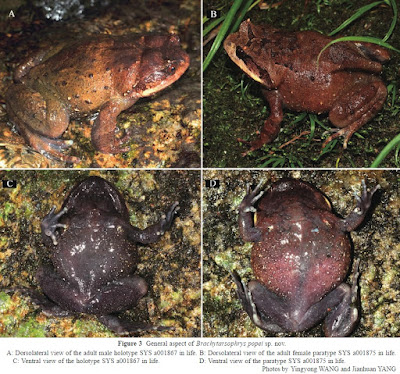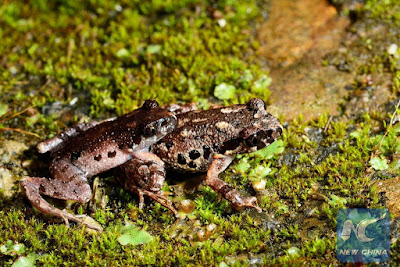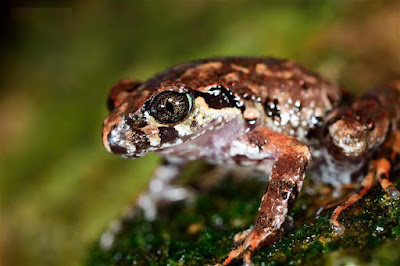[Most Recent Entries] [Calendar View]
Monday, March 14th, 2016
| Time | Event | ||||||
| 12:34a | [Herpetology • 2014] Brachytarsophrys popei • A New Species of the Genus Brachytarsophrys Tian and Hu, 1983 (Anura: Megophryidae) from Southern China Based on Molecular and Morphological Data
ABSTRACT A new species, Brachytarsophrys popei sp. nov., is described based on a series of specimens collected from Mount Jinggang, Jiangxi Province, Taoyuandong Nature Reserve, Hunan Province and Nanling Nature Reserve, Guangdong Province, China. The new species can be easily distinguished from other known congeners by morphology, morphometrics and molecular data of the mitochondrial 16S rRNA gene. It is characterized by its relatively small size with 86.2 mm in snout-vent length in adult female and 70.7 mm–83.5 mm in males; vomerine teeth bearing on two markedly elevated ridges, which projecting behind far beyond the posterior level of the choanae, widely separated by a distance nearly 1.5 times length of one; margin of tongue deeply notched behind; toes about one-third to two-thirds webbed in males, at most one-third webbed in female; the webs extending as a wide fringes along either side of toes; upper eyelid with tubercles, one of which is enlarged and becoming a remarkably prominent, bluntly conical light- yellow horn; black tiny nuptial spines on the dorsal surface of the first finger and second finger base, single vocal sac in males; gravid females bear pure yellowish oocytes; tadpoles with a transverse white stripe on ventral surface and two longitudinal white stripes along the sides of body. The new species represents the fifth known Brachytarsophrys species. Etymology: The specific name “popei” is in honour of the noted American herpetologist Clifford H. Pope (1899–1974), in recognition of his efforts on biodiversity surveys and research of amphibians and reptiles in Southeast China. We propose the standard name “Pope’s Short-legged Toad”, chinese name “Po Shi Duan Tui Chan”. Distribution: Currently, B. popei sp. nov. is distributed in the middle section of Luoxiao Mountains and Nanling Mountains in southern China, including three type localities: the Mount Jinggang, Jiangxi Province, the adjacent Taoyuangdong NR, Hunan Province, and the Nanling NR, Guangdong Province, China. In addition, the Yizhang County, Hunan Province bordered with the Nanling Nature Reserve, thus, population as B. carinense from Yizhang County of Hunan should be the B. popei sp. nov. Jian Zhao, Jian-Huan Yang, Guo-Ling Chen, Chun-Quan Chen and Ying-Yong Wang. 2014. Description of A New Species of the Genus Brachytarsophrys Tian and Hu, 1983 (Amphibia: Anura: Megophryidae) from Southern China Based on Molecular and Morphological Data. ASIAN HERPETOLOGICAL RESEARCH. 5(3):150-156 DOI: 10.3724/SP.J.1245.2014.00150 | ||||||
| 1:37a | [Ichthyology • 2016] Amaralia oviraptor • A New Species of Amaralia Fowler (Siluriformes: Aspredinidae) from the Paraná-Paraguay River Basin
Abstract A new species of the banjo catfish genus Amaralia is described from the Paraná-Paraguay River Basin in central-western Brazil, Paraguay and northern Argentina. Amaralia oviraptor is distinguished from its single and allopatric congener, Amaralia hypsiura, by the greater number of dorsal-fin rays (3 vs. 2); by the absence of lateral contact between middle and posterior nuchal plates (vs. middle and posterior nuchal plates contacting each other laterally); and by a longer cleithral process (17.4–19.5 % of SL, mean 18.2 % vs. 14.0–17.2 % of SL, mean=15.5 %). Comments on the peculiar oophagic diet of Amaralia and an extended diagnosis of the genus are provided. Keywords: Pisces, Neotropical, biodiversity, banjo catfish, osteology, oophagy
John P. Friel and Tiago P. Carvalho. 2016. A New Species of Amaralia Fowler (Siluriformes: Aspredinidae) from the Paraná-Paraguay River Basin. Zootaxa. 4088(4) Resumo: Uma nova espécie de Amaralia é descrita da bacia do Paraná-Paraguai no Centro-Oeste do Brasil, Paraguai e Norte da Argentina. Amaralia oviraptor difere-se do seu único congênere de distribuição alopátrica, Amaralia hypsiura, pelo maior número de raios da nadadeira dorsal (3 vs. 2); pela ausência de um contato lateral entre a placa nucal mediana e a placa nucal posterior (vs. placa mediana e posterior contatando uma a outra lateralmente); e por um processo cleitral mais longo (17.4–19.5 % do CP, média = 18.2 % vs. 14.0–17.2 % do CP, média = 15.5 %). Comentários sobre o gênero são feitos acerca de sua dieta oofágica e uma diagnose entre os aspredinídeos é fornecida. Palavras-chave: Neotropical, biodiversidade, bagre banjo, osteologia, oofagia. | ||||||
| 4:21a | [Herpetology • 2016] Pristimantis iiap • A New Species of the Pristimantis conspicillatus Group (Anura: Craugastoridae) from the Peruvian Amazon
ABSTRACT We name and describe a new species of Anura, Pristimantis iiap, from the lowlands of the Peruvian Amazon, and allocate it to the Pristimantis conspicillatus group (sensu Padial et al. 2014). The new species was collected along the Sepahua River, a small tributary of the Urubamba River (Departamento Ucayali, Peru) running west from the slopes of the Fitzcarrald Arch. Individuals were found active at night in the understory of evergreen lowland forest with high density of bamboo (Guadua spp.). The new species is characterized by having complete and conspicuous dorsolateral folds, a slightly granular belly, a first finger slightly shorter than second, with large discs on fingers and toes (especially Fingers III and IV), a bright orange groin, and by lacking well-defined orange spots on the back of thighs and shanks. The advertisement call is composed of a single pulsed note with an average of 15 pulses/note, a pulse rate of 205 pulses/s, an average call length of 75 ms, and average fundamental and dominant frequencies of 1857 Hz and 3690 Hz, respectively. Pristimantis iiap occurs in sympatry with three other species of the group, P. buccinator (Rodríguez, 1994), P. fenestratus (Steindachner, 1864), and P. skydmainos (Flores and Rodríguez, 1997). Although only known from two close localities, we expect P. iiap to occur in similar forests along the Fitzcarrald Arch and on the eastern slopes of Cordillera Vilcabamba and Cordillera del Sira. Keywords: Alto Purus National Park, Brachycephaloidea, Fitzcarrald Arch, Guadua forest, terraranas, Urubamba River basin José M. Padial, Giussepe Gagliardi-Urrutia, Juan C. Chaparro and Roberto C. Gutiérrez. 2016. A New Species of the Pristimantis conspicillatus Group from the Peruvian Amazon (Anura: Craugastoridae). Annals of Carnegie Museum. 83(3):207-218. DOI: 10.2992/007.083.0302 @CarnegieMNH Instituto de Investigaciones de la Amazonía Peruana: IIAP | ||||||
| 4:28a | [Herpetology • 2016] Leptolalax tengchongensis • A New Species of the Genus Leptolalax (Anura: Megophryidae) from Mt. Gaoligongshan of western Yunnan Province, China
Abstract A new species of the genus Leptolalax is described from the Tengchong Section of Gaoligongshan National Nature Reserve, Tengchong County, Yunnan Province, China. The new species, Leptolalax tengchongensis sp. nov., can be distinguished from its congeners by a combination of the following characters: (1) small size (SVL 23.9–26.0 mm in males, 28.8–28.9 mm in females); (2) dorsal skin shagreened and scattered with fine, round reddish tubercles; (3) toes with rudimentary webbing and narrow lateral fringes; (4) tympanum distinctly discernible, almost entirely black; (5) ventrolateral glands indistinct; (6) flanks with several distinct and large dark blotches; (7) ventral surfaces white, scattered with distinct irregular dark speckling; (8) iris not bicolored, uniformly dark brown and scattered with minute, coppery reticulations throughout. To date, the new species has only been found at its type locality in evergreen broadleaf forests at elevations between 2000–2100 m. Keywords: Amphibia, Megophryidae, taxonomy, Leptolalax tengchongensis sp. nov., Tengchong, China
Discussion: The discovery of Leptolalax tengchongensis sp. nov. brings the number of Leptolalx recorded from China up to eight. The new species is also the third known species in the genus inhabit elevations above 2000 m; the other high elevation two species are L. alpinus (1150–2400 m) from Yunnan Province of China (Fei et al. 2010) and L. botsfordi (2795–2815 m) from northern Vietnam (Rowley et al. 2013). Species of the genus Leptolalax are small frogs inhabiting the forest floor in montane evergreen forest, and cryptic in both coloration and behavior (Rowley et al. 2015b). Intensified survey efforts in recent years and the use of an integrated approach incorporating morphological, molecular and acoustic data have resulted in continued discovery new species in the region, in particularly from Indochina (eg. Poyarkov et al. 2015a and Rowley et al. 2015b). Future herpetological exploration and study in southern China will likely continue uncovering new Leptolalax species from the region. Jian-Huan Yang, Ying-Yong Wang Guo-Ling Chen and Ding-Qi Rao. 2016. A New Species of the Genus Leptolalax (Anura: Megophryidae) from Mt. Gaoligongshan of western Yunnan Province, China. ZOOTAXA. 4088(3):379-394. DOI: 10.11646/zootaxa.4088.3.4 New species of genus Leptolalax, aka Asian litter frog, found in SW China's Yunnan https://t.co/IyB4YPrauy http://news.xinhuanet.com/english/2016-0 |
| << Previous Day |
2016/03/14 [Calendar] |
Next Day >> |








